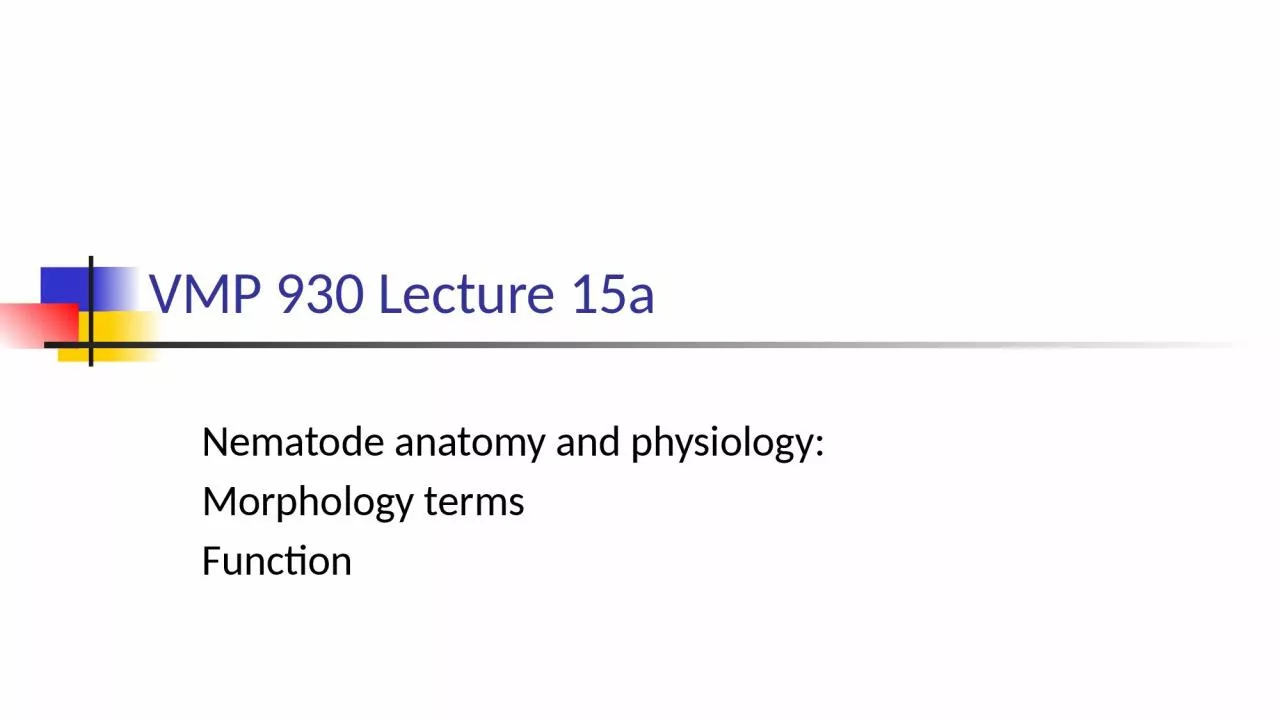

Morphology terms Function General anatomy and physiology Objective Define anatomical terms with regard to function in the worm pseudocoelom body cavity fluidfilled under pressure so that worm can move when muscles contract Movement is essential for nematode survival ID: 1009736
Download Presentation The PPT/PDF document "VMP 930 Lecture 15a Nematode anatomy and..." is the property of its rightful owner. Permission is granted to download and print the materials on this web site for personal, non-commercial use only, and to display it on your personal computer provided you do not modify the materials and that you retain all copyright notices contained in the materials. By downloading content from our website, you accept the terms of this agreement.
1. VMP 930 Lecture 15aNematode anatomy and physiology:Morphology termsFunction
2. General anatomy and physiologyObjective - Define anatomical terms with regard to function in the worm.pseudocoelom - body cavity, fluid-filled under pressure so that worm can move when muscles contract. Movement is essential for nematode survival.dorsal and ventral cords - major nerves. Target of many anthelmintic (deworming) drugs. Nerve function is essential for survival.lateral cords - excretory system.
3. General anatomy and physiologyLongitudinal sectionCross sectionMovement inside hostMovement outside host
4. General anatomy and physiology Digestive system: Buccal cavity with or without teeth. Well developed or vestigial.
5. General anatomy and physiologyEsophagus: various forms identify larval stages and characterize families of nematodes.a. rhabditiformb. strongyliformc. filariformd. stichosomeabcd
6. General anatomy and physiology3. intestine is a straight tube, no bends.4. anus near posterior end.
7. General anatomy and physiologyAll nematodes in this course only reproduce sexually, except Strongyloides.Adult stage nematodes are male or female, not hermaphroditic like flat worms.malefemalemalefemalemalefemaleMale grasping female with his copulatory bursa
8. General anatomy and physiologyMales, smaller than females, have copulatory bursa for grasping female and copulatory spicules for guiding sperm. Long, tubular, winding reproductive tract.spiculesbursaspicules
9. General anatomy and physiologyFemales have a long tubular reproductive tract opening to outside at a vulva that may be anterior, posterior or mid body.ovavulvaVulvar flap
10. Discussion QuestionHow many different functions of nematodes depend on an intact nervous system?In other words, if you were developing a new drug to kill nematodes what might you measure to select candidate compounds?
11. VMP 930 Lecture 15bOrder Rhabditida; Genus: StrongyloidesObjectives:Describe the life cycle, especially routes of infection and how these are different in very young hosts compared to adult animals.Know the host age when it is most susceptible to patent infections with clinical signs.Know how to diagnose in different host species.
12. Order Rhabditida:Focus on the genus StrongyloidesExclusive to this nematode order: sexually reproducing free-living stage and parthenogenic adult parasitic stage.www.cdc.gov/dpdx/strongyloidiasis/Free-living male,note spiculeFree-living female, note ova
13. Order RhabditidaFocus on the genus StrongyloidesRhabditic mange – larval stages of free-living Rhabditis strongyloides penetrates skinAlso associated with Strongyloides sp. Skin penetration.Rhabditic mange
14. Order RhabditidaFocus on the genus StrongyloidesFree living adults have rhabditiform esophagus Parasitic adults small, only adult females found in small intestine of host, long filariform esophagus
15. Order RhabditidaFocus on the genus StrongyloidesFemales produce egg with L1L1: hatches quickly See L1 in fresh feces of human and dogSee larvated egg in other host speciesDiagnostic importance?Pathogenic importance?L1 in human feces
16. Order RhabditidaFocus on the genus StrongyloidesHomogonic cycleL1 to infective (skin penetrating) L3 within 24 hours.Autoinfection by skin penetration can lead to hyperinfection.Infective larva
17. Order Rhabditida: focus on the genus StrongyloidesHeterogonic cycleL1 to free-living adult females and males that produce more new L1. Increases number of infective L3 in environment (soil/bedding).Free-living adults in soil.“E” above
18. Order RhabditidaFocus on the genus StrongyloidesLactogenic route of infection.Infective larva in milk
19. Order RhabditidaFocus on the genus StrongyloidesSkin penetrating route of infection.Infective larvae in soil
20. Pathological lesions – Strongyloides Parasitic adult femalesParasitic adult femalesLung reaction to migrating larvaeEnteritis response to adult females
21. Pathological lesions – Strongyloides Larval migration to lungs and on to intestine via trachea in neonatal and young animals. In adult animals larval migration to mammary tissue and arrest until onset of lactation in females.Immunosuppressed adult host susceptible to hyperinfection and clinical signs.Otherwise the occurrence of clinical signs limited to neonatal and young animals.
22. Diagnosis and control: StrongyloidesDiagnosis: eggs containing larva in fresh feces of most host species. Exception: in dog, cat and man L1 are found in fresh feces.Mother infects newborn with milk containing L3. Mother will be fecal test negative. Babies will be shedding eggs or L1. How does mother get infected?Treat the babies to control the transmission. Until fecal negative.
23. Baermann techniqueStep 1: Place a 10-g or larger fecal sample in the center of a double layer of cheesecloth or gauze. Step 2: Wrap the edges around the fecal sample to make a pouch and secure it with the rubber band. Step 3: Pass a pencil or applicator sticks through the elastic band and suspend the pouch containing the fecal sample over the bowl of the hollow stem wine glass. Step 4: Fill the wine glass completely with tepid tap water. Be sure not to let the corners of the fecal packet hang over the sides of the wine glass because they act as a wick for water. Step 5: Allow the glass to sit for at least eight hours and preferably overnight. Step 6: Remove the feces and discard. Step 7: Using a transfer pipette or 1-ml syringe with a needle attached, aspirate a small amount water from the very bottom of the hollow stem of the glass. Step 8: Place a few drops on a slide, add a cover slip, and examine the slide under a microscopeAnne M. Zajac, DVM, PhD, DACVM (parasitology), Meriam Saleh, PhD, VETERINARY MEDICINE 2013
24. Treatment: Strongyloides(FYI not on test)Fenbendazole, 50mg/kg 5 days. For dogs. May add moxidectin as monthly treatment.Macrolid anthelmintics (ivermectin, and other avermectins). For humans and pigs.Febantel for horses used at 50 mg/kg.Oxibendazole for horses at 15 mg/kg.The above dosage/drug information is FYI, not for testing.
25. Discussion QuestionHow do nursing foals infect their mothers with Strongyloides?